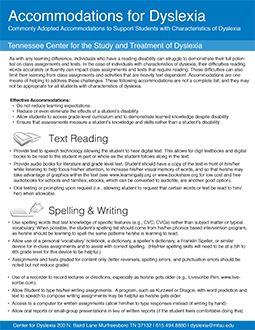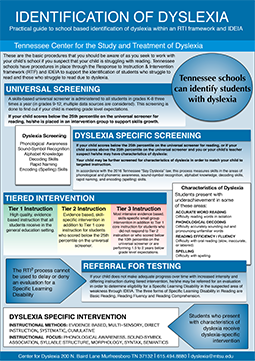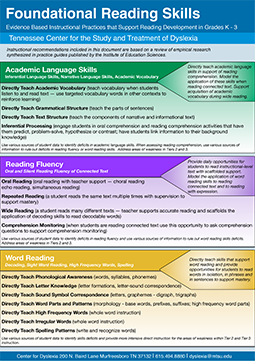What About Dyslexia?
Dyslexia is a specific learning disability that is neurobiological in origin. It is characterized by difficulties with accurate and/or fluent word recognition and by poor spelling and decoding abilities. These difficulties typically result from a deficit in the phonological component of language that is often unexpected in relation to other cognitive abilities and the provision of effective classroom instruction. Secondary consequences may include problems in reading comprehension and reduced reading experience that can impede the growth of vocabulary and background knowledge.
International Dyslexia Association definition and the definition adopted in Tennessee HB 1735 / SB 2002
This definition of dyslexia is adopted by the state of Tennessee. It explicitly defines dyslexia as a specific learning disability. Any child identified with a specific learning disability in basic reading or a specific learning disability in reading fluency has been identified as having dyslexia under current federal and state laws.
"Characteristics of dyslexia" is a more inclusive term that does not require that a student be identified with a specific learning disability. The term is adopted in Tennessee HB 2616 / SB 2635. It was adopted to ensure that students who struggle with word reading skills in any grade (K - 12) receive appropriate direct systematic instruction to teach them to read words accurately and/or fluently in support of comprehending written language.
Both terms "dyslexia" and "characteristics of dyslexia" apply to public schools in Tennessee in accordance with Tennessee HB 1735 / SB 2002 and Tennessee HB 2616 / SB 2635.
Characteristics of People with Dyslexia
Frequently Asked Questions
How many people have dyslexia?
We do not really know how many people have dyslexia. Since there has not been a generally accepted definition until recently, estimates have varied widely. The National Institutes of Health have estimated that 15% of the population may be dyslexic. In Tennessee, we estimate that at least 100,000 students in K-12 classes may be dyslexic.
What causes dyslexia?
Dyslexia is a consequence of the way a person's brain is organized. Learning to read requires making the association between printed symbols and spoken words and spoken sounds. These associations must become firmly fixed in memory for reading to be fluent. People with dyslexia have great difficulty establishing these associations. The exact cause of the difference in the brain is not known, but recent research and new technology make it possible to identify some of the differences in the brains of people with dyslexia. Also, interviews suggest that dyslexia appears in families across generations. Currently, the search for the possible genetic basis of dyslexia is underway in various locations around the world.
Will colored lenses help a person with dyslexia read better?
There is no solid research evidence that using colored lenses will improve reading for dyslexics. For people with dyslexia to learn to read, they must receive many hours of careful, systematic instruction in the sound system of the language. Any other treatments which may be recommended and attempted should not replace direct instruction in reading and writing.
How do I know if my child has dyslexia?
If your child has had difficulty learning to read words and spell, she might have dyslexia. Young children with dyslexia typically have difficulty learning the alphabet, rhyming, and dividing words into their sounds. Many parents of students with dyslexia describe their children as bright and eager learners until they encounter instruction in reading. At such times, they often become frustrated. Sometimes these children are able to memorize enough words to appear as if they are reading. When the number of words they must memorize becomes overwhelming (about third grade), the difficulty with reading becomes apparent. Simply stated, if your child has unusual difficulty pronouncing the words when he/she reads and spelling the words he/she writes (compared to others of the same age), you should consider an assessment for dyslexia.
How can I have my child assessed for dyslexia?
If you think your child may be dyslexic, contact your school principal and explain your concern. Under the Individuals with Disabilities Education Improvement Act (IDEIA Reauthorization 2004) and Public Law 94-142, the Education for all Handicapped Children Act of 1978, you are entitled to have your child evaluated by the school. Generally, schools provide a basic evaluation and are required by state law to conduct testing to determine if a student struggles with reading due to characteristics of dyslexia. Should you wish to pursue the diagnosis privately, you should seek a qualified evaluator. If you decide to use a private evaluator, ask if this individual is familiar with diagnosing dyslexia and which areas she will be testing. A diagnosis of dyslexia can be made after these areas have been assessed: general ability, word recognition, word attack (sounding out words), spelling, reading comprehension, phonological processing and written expression. In addition, a comprehensive evaluation will include assessment of oral language skills which affect learning to read and write and must be included to help identify the potential cause of any area of underachievement in reading comprehension.
Can a person have dyslexia and have an attention deficit hyperactivity disorder (ADHD)?
Yes. Research indicates that individuals with dyslexia also can have attention deficit disorder (ADD).
Can dyslexia be cured?
No. Dyslexia is a lifelong condition. However, with appropriate remediation, individuals with dyslexia can learn to read and write. With good instruction, dyslexia becomes much less debilitating. Many students with dyslexia attend college and become successful in positions which require considerable reading and writing. Without this instruction, many people with dyslexia will suffer from frustration, decreased self-esteem, and difficulty maintaining employment commensurate with their ability.






